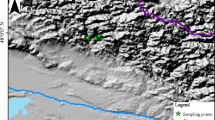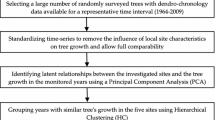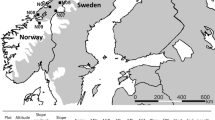Abstract
Temporal instability of forest climate-growth relationships has been evidenced at high elevations and latitudes, and in Mediterranean contexts. Investigations under temperate conditions, where growth is under the control of both winter frost and summer water stress, are scarce and could provide valuable information about the ability of forest to cope with climate change. To highlight the main climatic factors driving the radial growth of Quercus petraea forests and to detect their possible evolutions over the last century, dendroecological analyses were performed along a longitudinal gradient of both decreasing summer water stress and increasing winter frost in northern France (from oceanic to semi-continental conditions). The climate-growth relationships were evaluated from 31 tree-ring chronologies (720 trees) through the calculation of moving correlation functions. Q. petraea displayed a rather low sensitivity to climate. High temperature in March and water stress from May to July appeared to be the main growth limiting factors. The sensitivity to winter precipitation and summer water stress decreased from oceanic to semi-continental conditions, whilst the correlation to winter frost tended to increase. Moving correlations revealed a general instability of climate-growth relationships, with a moderate synchronicity with climatic fluctuations. The main changes occurred during previous autumn for both temperature and precipitation whilst climatic trends were rather low or non-significant. The most coherent trends were pointed out (i) in April with a cooling (−0.9°C) leading to positive correlation to temperature at the end of the century, and (ii) in July with a decreasing inter-annual variability of precipitation resulting in a loss of correlation. On the contrary, the decreasing temperature and increasing precipitation in May and June led to few significant changes climate-growth relationships.






Similar content being viewed by others
References
Andreu L, Gutiérrez E, Macias M, Ribas M, Bosch O, Camarero JJ (2007) Climate increases regional tree-growth variability in Iberian pine forests. Glob Change Biol 13(4):804–815. doi:10.1111/j.1365-2486.2007.01322.x
Barbaroux C, Bréda N (2002) Contrasting distribution and seasonal dynamics of carbohydrate reserves in stem wood of adult ring-porous sessile oak and diffuse-porous beech trees. Tree Physiol 22(17):1201–1210. doi:10.1093/treephys/22.17.1201
Becker M (1989) The role of climate on present and past vitality of silver fir forests in the Vosges Mountains of northeastern France. Can J For Res 19(9):1110–1117. doi:10.1139/x89-168
Becker M, Nieminen TM, Gérémia F (1994) Short-term variations and long-term changes in oak productivity in northeastern France—the role of climate and atmospheric CO2. Ann Sci For 51(5):477–492. doi:10.1051/forest:19940504
Benichou P, Le Breton O (1987) Prise en compte de la topographie pour la cartographie des champs pluviométriques statistiques. La Météorol 7(19):23–34
Bergès L, Dupouey JL, Franc A (2000) Long-term changes in wood density and radial growth of Quercus petraea Liebl in northern France since the middle of the nineteenth century. Trees Struct Funct 14(7):398–408. doi:10.1007/s004680000055
Biondi F (1997) Evolutionary and moving response functions in dendroclimatology. Dendrochronologia 15:139–150
Bréda N, Huc R, Granier A, Dreyer E (2006) Temperate forest trees and stands under severe drought: a review of ecophysiological responses, adaptation processes and long-term consequences. Ann Sci For 63(6):625–644. doi:10.1051/forest:2006042
Briffa KR, van der Schrier G, Jones PD (2009) Wet and dry summers in Europe since 1750: evidence of increasing drought. Int J Climatol 29(13):1894–1905. doi:10.1002/joc.1836
Bunn AG (2008) A dendrochronology program library in R (dplR). Dendrochronologia 26(2):115–124. doi:10.1016/j.dendro.2008.01.002
Cedro A (2007) Tree-ring chronologies of downy oak (Quercus pubescens), pedunculate oak (Q-robur) and sessile oak (Q-petraea) in the Bielinek Nature Reserve: comparison of the climatic determinants of tree-ring width. Geochronometria 26:39–45. doi:10.2478/v10003-007-0005-2
Cochard H, Bréda N, Granier A, Aussenac G (1992) Vulnerability to air embolism of three European oak species (Quercus petraea (Matt) Liebl, Q. pubescens Willd, Q. robur L). Ann Sci For 49(3):225–233. doi:10.1051/forest:19920302
Cook ER, Kairiukstis LAE (1990) Methods of dendrochronology: applications in the environmental sciences. Kluwer Academic Publishers, Dordrecht, Boston, London
Cook ER, Peters K (1981) The smoothing spline: a new approach to standardizing forest interior tree-ring width series for dendroclimatic studies. Tree-Ring Res 41:45–53
D’Arrigo R, Wilson R, Liepert B, Cherubini P (2008) On the ‘Divergence Problem’ in northern forests: a review of the tree-ring evidence and possible causes. Glob Planet Change 60(3–4):289–305. doi:10.1016/j.gloplacha.2007.03.004
Davi H, Dufrêne E, François C, Le Maire G, Loustau D, Bosc A, Rambal S, Granier A, Moors E (2006) Sensitivity of water and carbon fluxes to climate changes from 1960 to 2100 in European forest ecosystems. Agric For Meteorol 141(1):35–56. doi:10.1016/j.agrformet.2006.09.003
Di Filippo A, Biondi F, Cufar K, de Luis M, Grabner M, Maugeri M, Saba EP, Schirone B, Piovesan G (2007) Bioclimatology of beech (Fagus sylvatica L.) in the Eastern Alps: spatial and altitudinal climatic signals identified through a tree-ring network. J Biogeogr 34(11):1873–1892. doi:10.1111/j.1365-2699.2007.01747.x
Dittmar C, Zech W, Elling W (2003) Growth variations of Common beech (Fagus sylvatica L.) under different climatic and environmental conditions in Europe—a dendroecological study. For Ecol Manag 173(1–3):63–78. doi:10.1016/S0378-1127(01)00816-7
Dolezal J, Mazurek P, Klimesova J (2010) Oak decline in southern Moravia: the association between climate change and early and late wood formation in oaks. Preslia 82(3):289–306
Ducousso A, Guyon JP, Kremer A (1996) Latitudinal and altitudinal variation of bud burst in western populations of sessile oak (Quercus petraea (Matt) Liebl). Ann Sci For 53(2–3):775–782. doi:10.1051/forest:19960253
Duplat P, Tran-Ha M (1997) Modelling the dominant height growth of sessile oak (Quercus petraea Liebl) in France. Inter-regional variability and effect of the recent period (1959–1993). Ann Sci For 54(7):611–634. doi:10.1051/forest:19970703
Fonti P, Garcia-Gonzalez I (2004) Suitability of chestnut earlywood vessel chronologies for ecological studies. New Phytol 163(1):77–86. doi:10.1111/j.1469-8137.2004.01089.x
Fonti P, Solomonoff N, Garcia-Gonzalez I (2007) Earlywood vessels of Castanea sativa record temperature before their formation. New Phytol 173(3):562–570. doi:10.1111/j.1469-8137.2006.01945.x
Friedrichs DA, Büntgen U, Frank DC, Esper J, Neuwirth B, Loffler J (2009a) Complex climate controls on 20th century oak growth in Central-West Germany. Tree Physiol 29(1):39–51. doi:10.1093/treephys/tpn003
Friedrichs DA, Trouet V, Büntgen U, Frank DC, Esper J, Neuwirth B, Loffler J (2009b) Species-specific climate sensitivity of tree growth in Central-West Germany. Trees Struct Funct 23(4):729–739. doi:10.1007/s00468-009-0315-2
Fritts HC (1976) Tree rings and climate. Academic Press, London, New York, San Francisco
Gaussen H, Bagnouls F (1952) L’indice xérothermique. Bull de l’Assoc des Géogr Fr 222–223(jan-fév):10–16
Gruber A, Strobl S, Veit B, Oberhuber W (2010) Impact of drought on the temporal dynamics of wood formation in Pinus sylvestris. Tree Physiol 30(4):490–501. doi:10.1093/treephys/tpq003
Guiot J (1991) The bootstrapped response function. Tree-Ring Bull 51:39–41
Hughes MK (2002) Dendrochronology in climatology—the state of the art. Dendrochronologia 20:95–116. doi:10.1078/1125-7865-00011
Jones PD, Moberg A (2003) Hemispheric and large-scale surface air temperature variations: an extensive revision and an update to 2001. J Clim 16(2):206–223. doi:10.1175/1520-0442(2003)016<0206:HALSSA>2.0.CO;2
Kelly PM, Leuschner HH, Briffa KR, Harris IC (2002) The climatic interpretation of pan-European signature years in oak ring-width series. Holocene 12(6):689–694. doi:10.1191/0959683602hl582rp
Lebourgeois F (1997) RENECOFOR—Etude dendrochronologique des 102 peuplements du réseau
Lebourgeois F (2006) Sensibilité au climat des Chênes sessile et pédonculé dans le réseau RENECOFOR. Comparaison avec les hêtraies. Rev For Fr 53(1):29–44
Lebourgeois F, Cousseau G, Ducos Y (2004) Climate-tree-growth relationships of Quercus petraea Mill. stand in the Forest of Berce (“Futaie des Clos”, Sarthe, France). Ann Sci For 61(4):361–372. doi:10.1051/forest:2004029
Lebourgeois F, Bréda N, Ulrich E, Granier A (2005) Climate-tree-growth relationships of European beech (Fagus sylvatica L.) in the French Permanent Plot Network (RENECOFOR). Trees Struct Funct 19(4):385–401. doi:10.1007/s00468-004-0397-9
Lebourgeois F, Pierrat JC, Perez V, Piedallu C, Cecchini S, Ulrich E (2010a) Simulating phenological shifts in French temperate forests under two climatic change scenarios and four driving global circulation models. Int J Biometeorol 54(5):563–581. doi:10.1007/s00484-010-0305-5
Lebourgeois F, Rathgeber CKB, Mérian P, Ulrich E (2010b) Sensitivity of French temperate forests to climate variability and extreme events: example of the French Network RENECOFOR. In: Edytem (ed) Panorama de la dendrochronologie en France, Dignes-les-Bains, 17 October 2009, pp 19–26
Legendre P, Legendre L (1998) Numerical ecology. Elsevier, New York
Lindner M, Maroschek M, Netherer S, Kremer A, Barbati A, Garcia-Gonzalo J, Seidl R, Delzon S, Corona P, Kolstrom M, Lexer MJ, Marchetti M (2010) Climate change impacts, adaptive capacity, and vulnerability of European forest ecosystems. For Ecol Manag 259(4):698–709. doi:10.1016/j.foreco.2009.09.023
Macias M, Andreu L, Bosch O, Camarero JJ, Gutiérrez E (2006) Increasing aridity is enhancing silver fir (Abies alba mill.) water stress in its south-western distribution limit. Clim Change 79(3–4):289–313. doi:10.1007/s10584-006-9071-0
Mérian P, Lebourgeois F (2011) Size-mediated climate-growth relationships in temperate forests: a multi-species analysis. For Ecol Manag 261(8):1382–1391. doi:10.1016/j.foreco.2011.01.019
Misson L, Rathgeber C, Guiot J (2004) Dendroecological analysis of climatic effects on Quercus petraea and Pinus halepensis radial growth using the process-based MAIDEN model. Can J For Res 34(4):888–898. doi:10.1139/X03-253
Moberg A, Jones PD (2005) Trends in indices for extremes in daily temperature and precipitation in central and western Europe, 1901–99. Int J Climatol 25(9):1149–1171. doi:10.1002/joc.1163
Moisselin JM, Schneider M, Canellas C, Mestre O (2002) Les changements climatiques en France au XXème siècle. Etude des longues séries homogénéisées de données de température et de précipitations. La Météorol 38:45–56
Morin X, Roy J, Sonie L, Chuine I (2010) Changes in leaf phenology of three European oak species in response to experimental climate change. New Phytol 186(4):900–910. doi:10.1111/j.1469-8137.2010.03252.x
Myers JL, Well AD (2003) Research design and statistical analysis, 2nd edn. Routledge Academic, New York
Nizinski JJ, Saugier B (1988) A model of leaf budding and development for a mature Quercus forest. J Appl Ecol 25(2):643–652
Ogren E (2000) Maintenance respiration correlates with sugar but not nitrogen concentration in dormant plants. Physiol Plant 108(3):295–299. doi:10.1034/j.1399-3054.2000.108003295.x
Petit RJ, Csaikl UM, Bordacs S, Burg K, Coart E, Cottrell J, van Dam B, Deans JD, Dumolin-Lapegue S, Fineschi S, Finkeldey R, Gillies A, Glaz I, Goicoechea PG, Jensen JS, Konig AO, Lowe AJ, Madsen SF, Matyas G, Munro RC, Olalde M, Pemonge MH, Popescu F, Slade D, Tabbener H, Taurchini D, de Vries SGM, Ziegenhagen B, Kremer A (2002) Chloroplast DNA variation in European white oaks—phylogeography and patterns of diversity based on data from over 2600 populations. For Ecol Manag 156(1–3):5–26. doi:10.1016/S0378-1127(01)00645-4
Piao SL, Ciais P, Friedlingstein P, Peylin P, Reichstein M, Luyssaert S, Margolis H, Fang JY, Barr A, Chen AP, Grelle A, Hollinger DY, Laurila T, Lindroth A, Richardson AD, Vesala T (2008) Net carbon dioxide losses of northern ecosystems in response to autumn warming. Nature 451(7174):49–52. doi:10.1038/nature06444
Piovesan G, Biondi F, Bernabei M, Di Filippo A, Schirone B (2005) Spatial and altitudinal bioclimatic zones of the Italian peninsula identified from a beech (Fagus sylvatica L.) tree-ring network. Int J Ecol 27(3):197–210. doi:10.1016/j.actao.2005.01.001
R Development Core Team (2010) R: a language and environment for statistical computing. R Foundation for Statistical Computing, Vienna, Austria. ISBN: 3-900051-07-0, URL http://www.R-project.org
Rossi S, Deslauriers A, Anfodillo T, Carraro V (2007) Evidence of threshold temperatures for xylogenesis in conifers at high altitudes. Oecologia 152(1):1–12. doi:10.1007/s00442-006-0625-7
Rotzer T, Grote R, Pretzsch H (2005) Effects of environmental changes on the vitality of forest stands. Eur J For Res 124(4):349–362. doi:10.1007/s10342-005-0086-2
Rozas V (2005) Dendrochronology of pedunculate oak (Quercus robur L.) in an old-growth pollarded woodland in northern Spain: tree-ring growth responses to climate. Ann Sci For 62(3):209–218
Schweingruber FH (1996) Tree rings and environment: Dendroecology. Swiss Federal Institute for Forest, Snow and Landscape Research, and Paul Haupt Verlag, Bern
Tardif J, Camarero JJ, Ribas M, Gutierrez E (2003) Spatio-temporal variability in tree growth in the Central Pyrenees: climatic and site influences. Ecol Monogr 73(2):241–257. doi:10.1890/0012-9615(2003)073[0241:SVITGI]2.0.CO;2
Tessier L, Nola P, Serre-Bachet F (1994) Deciduous Quercus in the Mediterranean region: tree-ring/climate relationships. New Phytol 126(2):355–367. doi:10.1111/j.1469-8137.1994.tb03955.x
Thomas FM, Gausling T (2000) Morphological and physiological responses of oak seedlings (Quercus petraea and Q. robur) to moderate drought. Ann Sci For 57(4):325–333
Tyree MT, Cochard H (1996) Summer and winter embolism in oak: impact on water relations. Ann Sci For 53(2–3):173–180. doi:10.1051/forest:19960201
Weber P, Bugmann H, Rigling A (2007) Radial growth responses to drought of Pinus sylvestris and Quercus pubescens in an inner-Alpine dry valley. J Veg Sci 18(6):777–792. doi:10.1111/j.1654-1103.2007.tb02594.x
Wigley TM, Briffa KR, Jones PD (1984) On the average value of correlated time series, with applications in dendroclimatology and hydrometeorology. J Clim Appl Meteorol 23:201–213. doi:10.1175/1520-0450(1984)023<0201:OTAVOC>2.0.CO;2
Zang C (2009) bootRes: bootstrapped response and correlation functions. R package version 02. http://CRANR-projectorg/package=bootRes
Zweifel R, Zimmermann L, Zeugin F, Newbery DM (2006) Intra-annual radial growth and water relations of trees: implications towards a growth mechanism. J Exp Bot 57(6):1445–1459. doi:10.1093/jxb/erj125
Acknowledgments
We gratefully thank the European Commission, the French Ministry for Agriculture and Fisheries (MAP), the National Institute for Agronomic Research (INRA) and the French Forest Service (ONF) for providing data and support to the present study. The first author was also funded by a PhD grant from the French Ministry of High Education and Scientific Research. We also wish to thank: M. Charru, R. Bertrand for their helpful discussions, and all people who took part to the field campaign. We acknowledge the editor’s and reviewers’ remarks which helped improving the article.
Author information
Authors and Affiliations
Corresponding author
Electronic supplementary material
Below is the link to the electronic supplementary material.
Rights and permissions
About this article
Cite this article
Mérian, P., Bontemps, JD., Bergès, L. et al. Spatial variation and temporal instability in climate-growth relationships of sessile oak (Quercus petraea [Matt.] Liebl.) under temperate conditions. Plant Ecol 212, 1855–1871 (2011). https://doi.org/10.1007/s11258-011-9959-2
Received:
Accepted:
Published:
Issue Date:
DOI: https://doi.org/10.1007/s11258-011-9959-2




